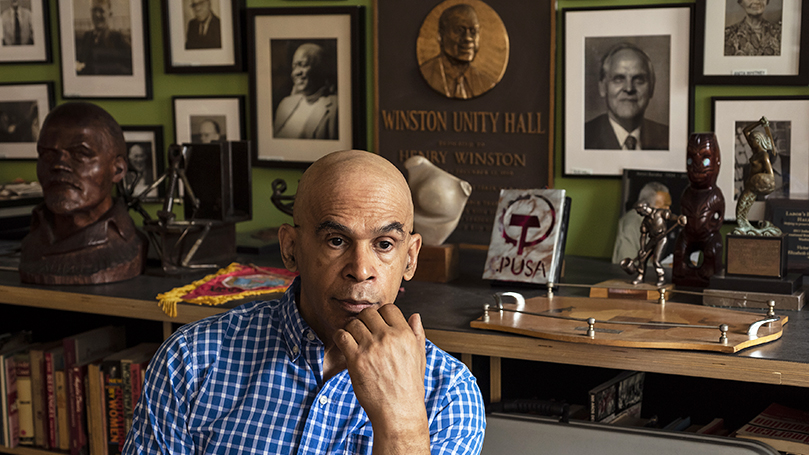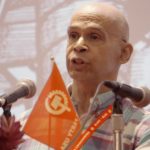
An interview with CP co-chair Joe Sims was recently published by Agoravox an Italian publication. The interview was conducted by Maddalena Celano. It has been edited for clarity and length.
Q. In Italy, when talking about Trump, one of the prevailing arguments states that his election victory reflects a right wing of the American working class, especially the white working class. Do you think the analysis is right? And, beyond its veracity, how could the American left respond to the threat of right-wing populism?
JS: Trump’s victory represents the right wing of the country, particularly the ruling and upper-middle class sections of the population. It’s true that a majority of whites who voted did so for Trump but this was true for other Republican presidential candidates as well. With respect to workers, his support came from more affluent sections of the class. Broadly speaking the resistance to the Trump administration is quite wide. There is a broad left, and broader center. The left in the U.S. is largely not organized in political parties but are involved in various organizations of civil society, trade unions, civil rights organizations etc. Most understand the need to defeat the extreme right and Trump.
Q. Trump’s political base is very similar to the basis of right-wing populism and right-wing parties around the world. They are not McDonald’s workers, nor necessarily bankers. Trump’s voter is more likely to be a regional manager. It is important to note that the United States is a large country, with many voters, and therefore it is easy to find millions of working-class members who voted for Trump. With his campaign he succeeded in convincing a sufficient part of the working class to transform the elections, in what was a tight victory that depended on the results of some states. What interests and social groups are hidden behind US right-wing populism?
The resistance to the Trump administration is quite wide
JS: It’s very clear that the extreme right in the U.S. is organized by and has major funding from big capital particularly finance capital.
Q. Alexandria Ocasio-Cortez, Rashida Tlaib and Ilhan Omar are the names that resonate most in the hegemonic media, but behind them there is a litter of socialists, mostly affiliated with DSA, many less than 30-years old, who are recording electoral victories across the country. Although he does not have the media presence of Ocasio-Cortez, Bhaskar Sunkara is regularly summoned to CNN and other mass media channels to talk about socialism. What distinguishes or differentiates American socialism from European socialism? In this situation, how does the American Communist Party fit in?
We cooperate with socialists and others on all issues where we find common ground
JS: Socialist parties in both the U.S. and Europe have common origins in the Second International and its aftermath. From a political standpoint the difference is that DSA is not a separate party but operates within the framework of the Democratic Party. Ideologically of course there are similarities: the management of capitalism through reforms instead of seeing the need to lay the basis for replacing capitalism through the struggle to take reforms to their logical conclusion. Hopefully the anti-communism that guided the socialists during the Cold War is no longer a factor. We cooperate with socialists on all issues where we find common ground and there are many.

Q. Sanders calls himself a democratic socialist. But I believe that the Jacobin magazine, as well as some sectors of the American left, have played an important role in capitalizing on the anger people have felt with liberalism. Occupy Wall Street, the 2011 Wisconsin uprising, the recent wave of teacher strikes, all these trials show growing discontent with some types of liberal democratic policies. Even Black Lives Matter, a new movement that denounces racism and violence against blacks, was born out of discontent with the same elected black politicians, who were only liberal Democrats. Jacobin succeeded in outlining a policy to the left of the reigning liberalism and affirming that this type of politics is, in general terms, a democratic socialist policy. To use a cliché: the rise of Sanders and the discontent generated by liberal policies have created the “objective conditions” to bring out a sort of revolt to the left of the liberal center. However, this revolt could easily have adopted a more populist language, such as Podemos. At this moment, what are the political initiatives and social struggles that the American Communist Party promotes in this context?
JS: Jacobin plays a certain role but the growth of socialist sentiment and organization is far broader, wider and deeper. It is an objective process that predates the Sanders candidacy in 2016- in fact Sanders capitalized on it. The revolt is not just against liberals but against the right wing as well. Occupy for example was a revolt against neo-liberal austerity. The CPUSA works on the basis that the day-to-day struggles of the working class and poor for jobs, health care, housing, police violence, student debt a safe environment etc – this is the basis upon which real change can and must be built.
Q. Racism, xenophobia, sexism, homophobia and other forms of hatred and intolerance proliferate both in the United States and in Europe. More and more political parties, including government parties, incite racism and xenophobia, directing their campaigns against refugees and migrants. How do you plan to combat hate speech, intolerance, discrimination and violence?
The struggle against discrimination and for unity is unique and indispensable
JS: The struggle against discrimination and for unity is a unique and indispensable part of the struggle for a new socialist society. These are “all-class” democratic battles that must be championed in their own right. They all demand special compensatory measures to address past discrimination. For examples, reparations and affirmative action for people color, women, lgbtq people etc. We reject the dismissal of these struggles as “identity politics.” Let’s recall that the working class in the U.S. is multi-racial and male and female. Unity of the class demands that the special interest of all be addressed.
Q. The American Communist Party has a very sad history as its members have been persecuted and marginalized for many years. Currently, how is the “American communist” perceived?
JS: Anti-communism is declining though still a force. The biggest weapon against it is the fight for our public presence and involvement in all struggles.
Q. How is your anti-imperialist struggle, against colonialism and the culture of war realized?
JS: The fight against U.S. imperialism is a permanent feature of our work be it Cuba and the embargo, Venezuela or the new deployment of medium range missiles. This will be so as long as imperialism exists.
Image: Margherita Mirabella


 Join Now
Join Now